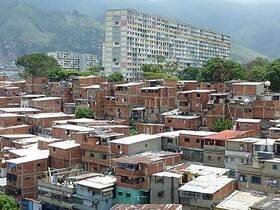Simone Rots is currently working on her PhD at Technische Universiteit Delft. She is simultaneously directing the Hofbogen project, a massive regeneration project that will transform the old Hofplein viaduct into a busy cultural and arts district. Alongside this work, Simone has been a part of Crimson Architectural Historians since it took on the WiMBY! project in Hoogvliet.
Research
The Squatted New Town: Informality and New Towns, Venezuelan Case Studies
The Squatted New Town is an intensification of a part of the research ‘The New Town’, initiated by Crimson Architectural Historians. ‘The New Town’ focuses on a generation of specific new towns: the modernistic satellite cities and urban extensions erected all over the world in the post-war period as the idealistic and pragmatic answer to population growth, war damage and housing shortages following World War II.
At the moment the new towns of this generation are worldwide considered worn out and old-fashioned. They are being blamed for the existence of social problems and cultural difficulties. The restructuring that follows on this conclusion often results in demolishing important parts and rebuilding them again. But is this the answer to these problems or can we learn form the modernistic cultural heritage and the way we have lived in them for decennia? What has become of the new towns of the fifties and sixties? Aim is to find the confrontation between the concept, the intentions, the design of the new towns and the build reality and use in the past decades until the present situation.
In the Squatted New Town two of the 22 case studies that are defined in ‘The New Town’ will be surveyed more thorough on the theme of the planned city versus the unplanned city. Also their position in the international network of modernistic planning will be analyzed. The two new towns are located in Latin America, in Venezuela: 23 de Enero in Caracas and Ciudad Guayana. 23 de Enero is a new town from the fifties in which the unplanned city literally took over, but still the planned new town is very present in its existence. This ‘revolutionary’ new town has a turbulent history and in the present situation bottom-up projects are initiated, trying to solve the problems in this socially, politically and economically self-organized town. Ciudad Guayana is one of the largest examples of a centralized planned city in Latin America. Together with the Joint Centre of Urban Studies of Harvard University and MIT, the Venezuelan government initiated the development of the master plan during the years resulted in a more community based participatory model. Already in the beginning the problems of self-organization were being recognized and sites-and-services were provided. This resulted in a much lower percentage of illegal housing compares to other Venezuelan cities.
The selection of these case studies is related to the fact that the developing countries provide examples of cities in which the confrontation between the planned parts and their unplanned additions is manifest. The social and economical distinction between the higher and lower classes of the society appear in the urban structure of the city. In the last decades the urbanisation went worldwide through a rapid growth and this consequently expressed itself in an informal development that influenced the urban pattern of the new towns. Another important reason for choosing these new towns is that they are products of the worldwide export of the modernistic way of thinking in architecture and planning from Western Europe from the first half of twentieth century onwards.
Next to these criteria the two new towns in Venezuela are selected because they are clear examples of the modernistic new towns of the fifties and sixties, the original plans are influenced by the CIAM principles and they are connected to the international network of designers and ‘develop-powers’ that were part of the Cold War. But both cities have there own specific themes that has to be analyzed more thorough. Although they both belong to a similar generation of new towns, they differ when it comes to the interpretation of modernism, the development of the original plan, the planning process and the realisation. Analyzing and comparing these two case studies will open up a source of information about the possibilities of adjustment of modernism to the past decades of daily life, political and economical changes and the local culture.
This research analyzes two case studies that represent specific combinations of ‘the planned versus unplanned’ theme and will provide insight in the way these urban developments have adapted themselves to the present situation. Placed in the international context of the INTI and of the Crimson project ‘the New Town’ the received expertise and knowledge will be exchanged with comparable new towns. The results can be used as ammunition for the urban planners and architects, because at both levels (architecture and urban planning) ‘the planned versus unplanned’ is reality.
PhD
Phd candidate, Delft University of Technology, faculty of Urbanism and the International New Towns Institute (INTI) in Almere. Co-financed by International New Towns Institute
Promotor: Prof. dr. V.J. Meyer
Tutor: dr. M. Provoost


